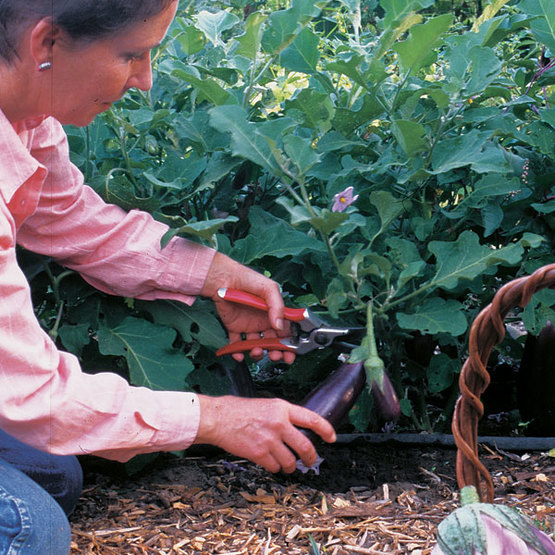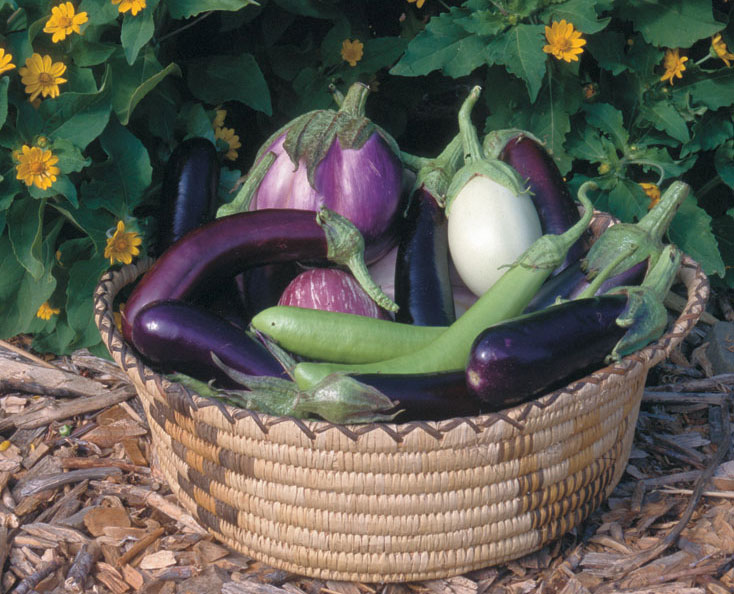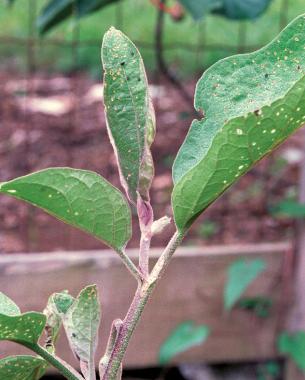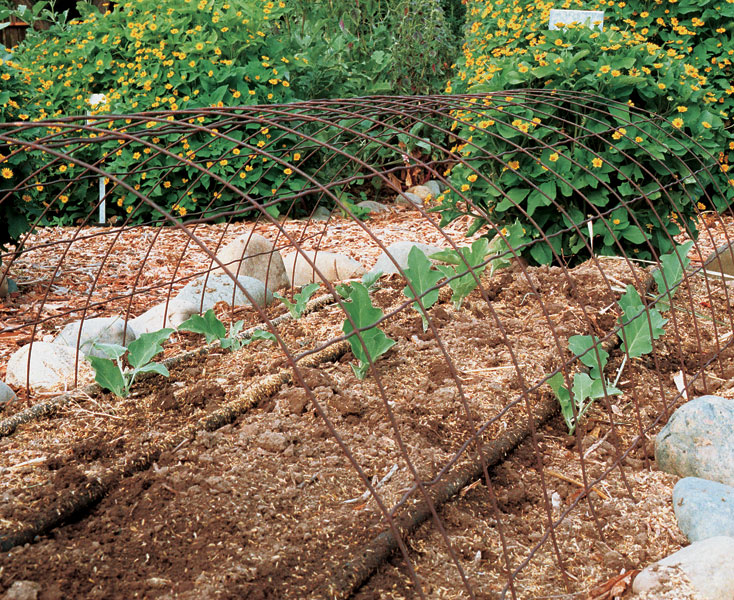Growing Eggplants Successfully
Give them a healthy start, and they’ll thrive in spite of flea beetles

As much fun as it is to peruse the great variety of eggplants offered in catalogs and imagine all the delicious options for preparing them, it’s easy to lose sight of what comes in between growing them. Eggplants can be a finicky crop, but if you can get them off to a good start, keep them warm, and keep pest damage to a minimum, an excellent harvest awaits you. Then the trouble you’ve taken to choose just the right eggplant for the dish of your dreams will pay off.
My favorite eggplant dishes are caponata, baba ghanoush, grilled eggplant steaks, stuffed eggplant, marinated slices, and stir-fried eggplant. Each one is best with the right kind of eggplant. But first things first.
Get an edge on starting eggplants

Once you’ve chosen the seed, your first task is getting those seeds started, which can be tricky with eggplant. Plan to start your seeds 8 to 10 weeks before your last frost date. That will allow your plants enough time to become sturdy. Bottom heat is essential to reach that goal. Heating cables help, but they may not suffice, since most are set for 70°F and eggplant prefer it a bit warmer, ideally 75°F. I sometimes cover my flats to conserve bottom heat and to allow all of the soil mix to warm thoroughly before I sow seeds.
Eggplant seeds should be very lightly covered with soil mix. Bottom watering systems, which use capillary action to provide water to the soil mix, help prevent seeds from washing deep into the mix, which sometimes results from overhead watering. If you do use overhead watering, I suggest using a very fine mist.
Supplemental light isn’t necessary until the seeds have germinated, but I start it right away. This mimics the ideal growing conditions for eggplants and helps promote bushy, sturdy growth.
Twelve to 14 hours of bright light will help prevent the plants from getting leggy. I set my lights 6 inches above the flats. Natural lighting in greenhouses is usually sufficient in the middle and southern regions of the United States. But natural light may need help in the North.
Eggplant seeds germinate in 7 to 14 days, depending on the heat, moisture provided, and moisture content and age of the seed. Seedlings with two sets of leaves can be transplanted into 4-inch or 2-by-2-by-6-inch pots two to three weeks after germination. The bottom heat should be continued until daytime temperatures are in the 70s. Most potting mixes include fertilizer, but if yours doesn’t, you can’t just forget about it. I feed my seedlings with pelleted fertilizer or twice-weekly applications of half-strength fish emulsion. And as the plants grow, I move the light source to just 2 inches above the plants. An additional six weeks of growth will produce plants that rival those at the garden center.
Don’t buy plants too early
|
|
|
It might be easier just to purchase eggplant starts at the garden center; however, the selection won’t be as great as that offered in seed catalogs. If the idea of purchasing plants sounds good to you, here’s a tip: I usually see eggplant starts for sale much too early in the season and would advise any gardener to wait until the soil has warmed, the days are consistently sunny, and all threat of frosty or cold nights has passed before buying. Patience will be rewarded. Eggplants do not like to be cold and will suffer.
Always look for short and stocky plants that are not root bound; check the drainage hole to make sure roots are not protruding. The plants should not have flowers or fruits already formed. If you feel the need to buy before the plants are sold out, make sure you transplant them into gallon containers to give the root system room to develop. Place them outdoors during the day and indoors at night until the weather warms sufficiently.
Fight pests with healthy plants

When it’s time to set the plants out in the garden, I put them in well-dug beds with good drainage. In hot climates, young plants need to be watered twice a week, to a depth of 12 inches.
Eggplants do not like standing water, so mature plants should be watered deeply and infrequently. But do not allow the leaves to wilt during the day. If water is adequate and wilting still occurs, I check for root-knot nematode damage by digging into a section of side roots and looking for the nematode knots in the roots. The best defense against root-knot nematode damage is a healthy root system.
Eggplants are very susceptible to flea beetles, which make pinholes in the leaves and can cause considerable damage. The plants can be covered with row covers early in the season to help prevent the first wave of flea beetles. Some very preliminary research shows that applying predatory nematodes can significantly decrease the number of flea beetle larvae and subsequent damage.
Most healthy plants, however, will recover from the leaf damage. I feed my eggplants once or twice during the growing season with a light application of fish emulsion, manure tea, or compost tea. This helps to supply potassium, which the plants need to keep producing fruit.
As the plants grow and bear, they will need support. I use tomato cages or wire loops to give my eggplants a shoulder to lean on. Asian varieties will grow to about 18 inches tall, and the larger-fruited plants usually grow 24 to 36 inches tall.
If you’ve treated the crop well, you should have a bountiful harvest. I pick eggplants when they are bright and shiny. Dull-skinned fruits have begun to form mature seeds and tough skin. In very warm climates, eggplants may not reach full size before losing their shine. I don’t hesitate to harvest them when they are small so I can enjoy firm, mild, seedless flesh.
Match the eggplant to the recipe

I always grow enough, and enough variety, that I have the eggplants I need for just the dish I want to eat. Caponata, a bold Italian combination of eggplant, tomatoes, onion, capers, olive oil, and vinegar, looks much more vibrant with a white-skinned eggplant. ‘Casper’, ‘White Beauty’, ‘White Sword’, or any of the other white eggplants work well. Using purple-skinned eggplants can create a muddy effect.
Baba ghanoush, a grilled eggplant purée with sesame paste and garlic, and hunkar begendi, a roasted eggplant purée with kasseri cheese, also benefit from using white-skinned eggplant. The light color makes the purée more appealing and better shows off any garnishes.
Grilled eggplant steaks are best with firm-fleshed fruits 4 to 6 inches in diameter. They hold up on the grill and look substantial on the plate. These larger varieties are also best for papoutsakia, a classic Greek stuffed and baked eggplant dish. Musakka, baked eggplant with tomato, béchamel, and cheese, may be made with many sizes of eggplant, although the large round slices are easier to work with and hold a nice shape. ‘New York Improved’, ‘Harris Special High Bush’, ‘Pompano Pride’, ‘Fort Myers Market’, and ‘Listada de Gandia’ are excellent choices when large eggplants are needed. They have the added advantage of performing well in most areas of the United States.
For marinated eggplant you want to preserve, the eggplant must be sliced to fit conveniently in a jar. The job is made much easier if the eggplant is the same diameter as a pint-size canning jar. The slices will stack easily and fit neatly in the jar, which will make retrieving unbroken pieces much easier. Any variety that fits inside a wide-mouth, pint-size canning jar works well. My favorite is ‘Rosita’, not only for size but also for its beautiful lavender-pink color and mild flavor. ‘Diamant’, an early purple variety from Russia, is an excellent choice in cooler climates.
The long, skinny Asian eggplants are perfect for stir-frying. Neat, round, 1- to 2-inch-diameter slices make preparation and cooking easy. No fancy knife work is necessary, and the pieces can easily be cut to a uniform size for fast and even cooking. The pieces are also a perfect size to pick up with chopsticks.
‘Taiwan Pingtung Long’, ‘Slim Jim’, ‘Thai Green’, and ‘Waimanalo Long’ are all great stir-fry varieties that are well adapted to most regions of the United States. Long Asian eggplants are also perfect for drying. The thinly sliced rounds dry quickly and are very uniform. I grind dry rounds in a coffee grinder that I use only for herbs and then store the powder in a clean glass jar. I like to use it as a thickener or subtle flavoring for purées, stocks, and stews.







Comments
How to grow zucchini in a warm area? Insects are much like zucchini....hard to grow it!
Radishes. Plant radishes with your zucchini and yellow squash and the squash beetles won't be a problem. Any radish will do, but the ice cycle or dikon radish seems to work best, I've found.
Also plant your zucchs and squash in a raised bed and/or a mound. Zucchs, cukes, squash, and melons don't like "wet feet" as the saying goes. In other words, the roots should be wet but not the stems of the plants, which will cause rot and possible vine borers.
Also, where I live in Oklahoma, the summers get so hot that it stresses the zucchini and squash in July and August. If your area is very, very warm (HOT), like mine is, then consider planting them in a spot where they get partial afternoon shade. Mine are interplanted with radishes in two large hugelkultur beds where they get afternoon shade from two pear trees...perfect conditions for my climate.
its good comment
Flee beetles are my arch nemesis. They have decimated some very beautiful eggplants that I've grown from seed. I've tried companion planting with marigolds, lavender, and chrysanthemum, but to no avail. Has anyone found a companion plant that will stave them off?
@Kenneth King, I've found that bush beans as a companion plant for eggplant thwart some pests such as snails and cucumber beetles. However, the only thing I've found to work for flea beetles is a neem oil spray. (Few drops of Neem oil, a tsp of non-detergent natural soap mixed into a gallon of water in a sprayer.) It's all natural, although you have to spray in morning or evening when it's cool and during times bees and other pollinators aren't out since it can harm them as well. Works like a charm against flea beetle. I took precautions not to harm bees - not one was harmed.
Rotenone is organic; look it up on Wikipedia......Rotenone is an odorless, colorless, crystalline isoflavone used as a broad-spectrum insecticide, piscicide, and pesticide. It occurs naturally in the seeds and stems of several plants, such as the jicama vine plant, and the roots of several members of Fabaceae. It was the first described member of the family of chemical compounds known as rotenoids. Use a piece of sheers drapes or an old nylon stocking and put the rotenone in it. Make a bundle and give it a shake over the plant. I use in on all brassicas and it works great!
Log in or create an account to post a comment.
Sign up Log in